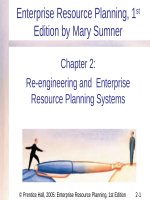Management by chuch williams chapter 02
Bạn đang xem bản rút gọn của tài liệu. Xem và tải ngay bản đầy đủ của tài liệu tại đây (1.15 MB, 30 trang )
Chapter 2
The History of
Management
MGMT
Chuck Williams
Designed & Prepared by
B-books, Ltd.
1
In the Beginning
After reading the next section,
you should be able to:
1. explain the origins of management.
2
Management Ideas and Practice
Throughout History
5000
5000BC
BC
Egyptians
4000-2000
Egyptians
4000-2000BC
BC
1.1
Sumerians
Sumerians
Record
Recordkeeping
keeping
Planning,
Plan,
controlling.
organize,
Planning,organizing,
organizing,
Plan,
controlling.
organize,control.
control.Written
Writtenrequests.
requests.
1800
1800BC
BC
Hammurabi
Hammurabi
Controls
Controlsand
andwritten
writtendocumentation
documentation
600
600BC
BC
Nebuchadnezzar
Nebuchadnezzar Wage
Wageincentives,
incentives,production
productioncontrol
control
500
500BC
BC
Sun
SunTzu
Tzu
Strategy
Strategy
400
400BC
BC
Xenophon
Xenophon
Management
Managementas
asaaseparate
separateart
art
400
400BC
BC
Cyrus
Cyrus
Human
Humanrelations
relationsand
andmotion
motionstudy
study
175
175
Cato
Cato
Job
Jobdescriptions
descriptions
284
284
Diocletian
Diocletian
Delegation
Delegationof
ofauthority
authority
900
900
Alfarabi
Alfarabi
Listed
Listedleadership
leadershiptraits
traits
1100
1100
Ghazali
Ghazali
Listed
Listedmanagerial
managerialtraits
traits
1418
1418
Barbarigo
Barbarigo
Different
Differentorganizational
organizationalforms/structures
forms/structures
1436
1436
Venetians
Venetians
Numbering,
Numbering,standardization,
standardization,interchangeability
interchangeability
1500
1500
Sir
SirThomas
ThomasMore
More Critical
Criticalof
ofpoor
poormanagement
managementand
andleadership
leadership
3
1525
1525
Machiavelli
Machiavelli
Cohesiveness,
Cohesiveness,power,
power,and
andleadership
leadership
Why We Need Managers Today
Then
Then
1.2
Now
Now
Work
Workin
infamilies
families
Work
Workin
infactories
factories
Skilled
Skilledlaborers
laborers
Specialized,
Specialized,
unskilled
unskilledlaborers
laborers
Small,
Small,self-organized
self-organized
groups
groups
Large
Large factories
factories
Unique,
Unique,small
small batches
batches
of
of production
production
Large
Large standardized
standardized
mass
massproduction
production
4
The Evolution of Management
After reading the next four sections,
you should be able to:
2. explain the history of scientific management.
3. discuss the history of bureaucratic and
administrative management.
4. explain the history of human relations
management.
5. discuss the history of operations, information
systems, and contingency management.
5
The History of
Scientific Management
Scientific
Scientific Management
Management
Studies
Studies and
and tests
tests methods
methods to
to identify
identify
the
the best,
best, most
most efficient
efficient ways
ways
“Seat-of-the
“Seat-of-the Pants”
Pants” Management
Management
No
No standardization
standardization of
of procedures
procedures
No
No follow-up
follow-up on
on improvements
improvements
2
6
Frederick W. Taylor
Frederick Taylor is known
today as the father of
scientific management.
One of his many
contributions to modern
management is the
common practice of giving
employees rest breaks
throughout the day.
2.2
7
Taylor’s Four Management
Principles
Develop
Develop aa science
science for
for each
each element
element of
of aa man’s
man’s work,
work,
which
which replaces
replaces the
the old
old rule-of-thumb
rule-of-thumb method.
method.
Scientifically
Scientifically select
select and
and then
then train,
train, teach,
teach, and
and
develop
develop the
the workman.
workman.
Cooperate
Cooperate with
with the
the men
men to
to insure
insure all
all work
work is
is done
done in
in
accordance
accordance with
with the
the principles
principles of
of the
the science.
science.
2.1
There
There is
is almost
almost equal
equal division
division of
of the
the work
work and
and the
the
responsibility
responsibility between
between management
management and
and workmen.
workmen.
8
Frank & Lillian Gilbreth
Frank and Lillian Gilbreth were prolific
researchers and often used their family as
guinea pigs. Their work is the subject of
Cheaper by the Dozen, written by their son
and daughter.
2.2
9
Motion Studies:
Frank & Lillian Gilbreth
Time Study
Timing how long it takes good workers
to complete each part of their jobs.
Motion Study
Breaking each task into its separate
motions and then eliminating those that are
unnecessary or repetitive.
2.2
10
Charts: Henry Gantt
2.3
11
The History of
Bureaucratic Management
Max Weber, 1864-1920
Bureaucracy
The exercise of control on the basis of
knowledge, expertise, or experience.
3.1
12
The Aim of Bureaucracy
1.
1. Qualification-based
Qualification-basedhiring
hiring
2.
2. Merit-based
Merit-basedpromotion
promotion
3.
3. Chain
Chainof
ofcommand
command
4.
4. Division
Divisionof
oflabor
labor
5.
5. Impartial
Impartial application
applicationof
ofrules
rulesand
andprocedures
procedures
6.
6. Recorded
Recordedin
inwriting
writing
3.1
7.
7. Managers
Managersseparate
separate from
fromowners
owners
13
Administrative Management:
Henri Fayol
3.2
1.
1. Division
Divisionof
ofwork
work
8.
8. Centralization
Centralization
2.
2. Authority
Authorityand
and
responsibility
responsibility
9.
9. Scalar
Scalarchain
chain
3.
3. Discipline
Discipline
10.
10.Order
Order
4.
4. Unity
Unityof
ofcommand
command
11.
11.Equity
Equity
5.
5. Unity
Unityof
ofdirection
direction
12.
12.Stability
Stabilityof
oftenure
tenure
of
of personnel
personnel
6.
6. Subordination
Subordinationof
of
individual
individual interests
interests
13.
13. Initiative
Initiative
7.
7. Remuneration
Remuneration
14.
14. Esprit
Esprit de
de corps
corps
14
The History of
Human Relations Management
Efficiency alone is not
enough to produce
organizational success.
Success also depends on
treating workers well.
4
15
Mary Parker Follett
Mary Parker Follett is
known today as the mother
of scientific management.
Her many contributions to
modern management
include the ideas of
negotiation, conflict
resolution, and power
sharing.
4.1
16
Constructive Conflict and
Coordination: Mary Parker Follett
Domination
Domination
Dealing
Dealing with
with
Conflict
Conflict
Compromise
Compromise
Integration
Integration
4.1
17
Constructive Conflict and
Coordination: Mary Parker Follett
Fundamental Principals of Organizations
1.
1. Coordination
Coordinationas
asreciprocal
reciprocalrelating
relatingall
all
the
thefactors
factorsin
inaasituation
situation
2.
2. Coordination
Coordinationby
bydirect
directcontact
contactof
ofthe
the
responsible
responsiblepeople
peopleconcerned
concerned
3.
3. Coordination
Coordinationin
inthe
theearly
earlystages
stages
4.
4. Coordination
Coordinationas
asaacontinuing
continuingprocess
process
4.1
18
Hawthorne Studies: Elton Mayo
4.2
• Workers’ feelings and
attitudes affected their
work
• Financial incentives
weren’t the most
important motivator for
workers
• Group norms and
behavior play a critical
role in behavior at work
19
Cooperation and Acceptance
of Authority: Chester Barnard
Managers can gain cooperation by:
Securing essential services from individuals
Unifying people by clearly formulating an
organization’s purpose and objectives
Providing a system of effective communication
4.3
20
Cooperation and Acceptance
of Authority: Chester Barnard
People will be indifferent to managerial
directives if they…
are understood
are consistent with the purpose of the
organization
are compatible with the people’s personal
interests
can actually be carried out by those people
4.3
21
Operations, Information, Systems,
and Contingency Management
Operations
Operations Management
Management
Information
Information Management
Management
Systems
Systems Management
Management
Contingency
Contingency Management
Management
5
22
Operations Management Tools
Quality
Qualitycontrol
control
Forecasting
Forecastingtechniques
techniques
Capacity
Capacityplanning
planning
Productivity
Productivitymeasurement
measurement and
andimprovement
improvement
Linear
Linearprogramming
programming
Scheduling
Schedulingsystems
systems
Inventory
Inventorysystems
systems
Work
Workmeasurement
measurementtechniques
techniques
Project
Projectmanagement
management
5.1
Cost-benefit
Cost-benefitanalysis
analysis
23
Operations Management Tools
Guns
Guns
Origins
Origins of
of
Operations
Operations
Management
Management
Geometry
Geometry
Fire
Fire
5.1
24
Whitney, Monge, and Olds
Eli Whitney, 1765-1825
Gaspard Monge, 1746-1818
Ransom Olds, 1864-1950
5.2
25









